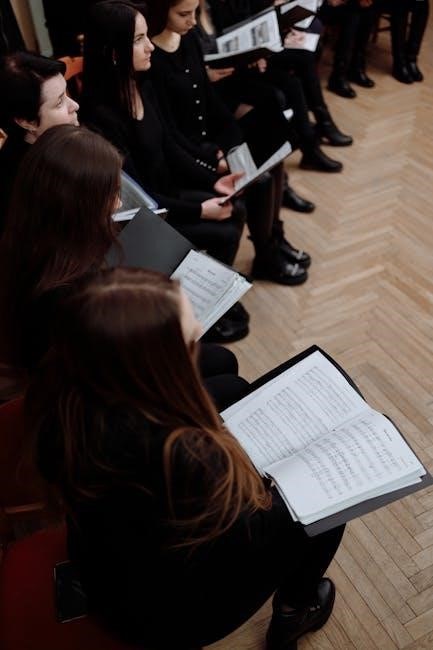Beginning Sounds Worksheets are essential tools for teaching phonics‚ helping children recognize initial sounds in words. These PDF resources‚ available for various age groups‚ combine educational activities like matching games‚ coloring‚ and word-picture exercises to make learning engaging and effective. They are designed to enhance phonological awareness and build foundational reading skills through interactive and fun exercises‚ suitable for preschool‚ kindergarten‚ and first-grade students.
1.1 Importance of Phonics in Early Education
Phonics is a cornerstone of early education‚ enabling children to decode words and develop reading skills. By focusing on beginning sounds‚ worksheets help build phonological awareness‚ a critical foundation for literacy. These resources introduce letter-sound relationships‚ fostering an understanding of how sounds combine to form words. Early phonics instruction boosts confidence and prepares children for more complex reading tasks. Worksheets like those mentioned earlier‚ such as Jolly Phonics Group 1 sounds and digraphs‚ provide structured practice‚ ensuring young learners grasp these essential skills effectively and enjoyably.
1.2 Role of Worksheets in Teaching Phonics
Worksheets play a vital role in teaching phonics by providing structured‚ hands-on activities that reinforce sound-letter associations. They offer a variety of engaging exercises‚ such as matching games‚ coloring activities‚ and word-picture matching‚ which cater to different learning styles. Worksheets like the Beginning Sounds Pack and Jolly Phonics Group 1 resources help children practice recognizing initial sounds‚ a crucial skill for decoding words. These tools are adaptable for different age groups‚ making them an invaluable resource for teachers and parents aiming to support early literacy development in a fun and effective manner.

Types of Beginning Sounds Activities
Activities include matching games‚ coloring tasks‚ word-picture exercises‚ and sound sorting. These interactive exercises help children identify and connect sounds with letters‚ fostering phonics skills effectively.
2.1 Matching Games for Sounds and Letters
Matching games are interactive activities where children connect sounds to corresponding letters or pictures. For example‚ students match the sound /k/ to the letter ‘c’ or a picture of a cat. These exercises improve phonological awareness by reinforcing the link between sounds and symbols. Some worksheets feature activities like drawing lines between sounds and pictures or coloring letters that match the beginning sound of an object. These games are engaging‚ making learning fun while developing essential reading skills. They are often used in kindergarten and preschool to build a strong phonics foundation.
2.2 Coloring Activities Based on Sounds
Coloring activities based on sounds are engaging tools for early learners. These worksheets typically present pictures or letters‚ with instructions to color items based on their beginning sounds. For example‚ students might color all objects starting with the /k/ sound‚ such as a cat or kite. These activities enhance phonological awareness and fine motor skills. They are simple yet effective‚ making learning fun and interactive. Many free PDF resources offer themed coloring sheets‚ making them accessible for teachers and parents to support phonics practice at home or in the classroom.
2.3 Word-Picture Matching Exercises
Word-picture matching exercises are interactive tools that help students connect sounds with visuals. These worksheets feature words alongside corresponding images‚ allowing learners to match items based on their beginning sounds. For example‚ pairing “cat” with a picture of a cat reinforces the /k/ sound. This activity strengthens phonological awareness and vocabulary skills. Many PDF resources offer printable versions of these exercises‚ making them easy to use in classrooms or at home. They are particularly effective for visual learners‚ providing a hands-on approach to mastering beginning sounds.
2.4 Sound Sorting Worksheets
Sound sorting worksheets are engaging tools that help students categorize words or images based on their beginning sounds. For example‚ learners might sort words starting with /b/ and /t/ into separate groups. These exercises enhance phonological awareness by encouraging students to focus on sound differences. Many PDF resources offer sound sorting activities with pictures or words‚ making them ideal for young learners. Teachers can customize these worksheets to target specific sounds‚ ensuring tailored practice for their students. This hands-on approach makes learning interactive and enjoyable‚ while reinforcing foundational phonics skills.

Age-Specific Worksheets
Age-specific worksheets cater to different developmental stages‚ offering tailored activities for preschoolers‚ kindergartners‚ and first graders. They provide engaging exercises suited to each age group’s skills‚ ensuring fun and effective learning.
3.1 Worksheets for Kindergarten Students
Kindergarten worksheets focus on introducing basic sounds through simple‚ engaging activities. They often feature large print‚ colorful visuals‚ and straightforward exercises like matching games and sound repetition. These worksheets help 5-6 year olds develop phonological awareness by connecting sounds to letters and pictures. Activities like tracing letters‚ identifying beginning sounds in words‚ and sorting objects by sounds are common. They are designed to be fun and interactive‚ laying the groundwork for reading skills while accommodating the attention span and skill level of young learners.
3.2 Worksheets for Preschoolers
Preschool worksheets are designed for 3-4 year olds‚ focusing on foundational sound recognition. They typically include simple‚ visually appealing activities like tracing large letters‚ matching sounds to pictures‚ and identifying beginning sounds in basic words. These worksheets use vibrant colors and familiar objects to engage young learners. Activities often involve repetition and play-based learning to introduce phonological awareness. They are short and repetitive‚ catering to shorter attention spans while laying the groundwork for understanding sounds and their relationship to letters. This early exposure helps build confidence and curiosity about reading.
3.3 Worksheets for First Grade Students
First-grade worksheets build on foundational skills‚ introducing more complex beginning sounds and letter-sound associations. Activities include identifying sounds in simple CVC words‚ matching letters to pictures‚ and writing short words. These worksheets often incorporate games like sound-based mazes or puzzles to keep learning engaging. They also focus on blending sounds into words‚ reinforcing phonemic awareness and early reading skills. With clear instructions and age-appropriate challenges‚ these worksheets help first graders transition smoothly from basic recognition to applying sounds in reading and writing tasks.

Creating Effective Beginning Sounds Worksheets
Effective worksheets should have clear objectives‚ visual aids‚ and interactive elements. They should be age-appropriate‚ engaging‚ and designed to reinforce sound recognition and early reading skills.
4.1 Incorporating Visual Aids
Incorporating visual aids like images‚ charts‚ and real-life examples enhances learning. Pictures help students connect sounds to objects‚ making abstract concepts concrete. Colorful illustrations engage young learners‚ improving focus and retention. Visual cues also support memory by associating sounds with familiar items. Worksheets with visual aids are particularly effective for early readers‚ as they bridge the gap between sounds and letters. This approach fosters phonological awareness and builds a strong foundation for reading skills. Visual elements make worksheets interactive and appealing‚ ensuring an enjoyable learning experience for children.
4.2 Designing Interactive Elements
Interactive elements‚ such as fill-in-the-blank exercises‚ movable letter tiles‚ and sound-tracing activities‚ make worksheets engaging. These features allow students to actively participate in learning‚ enhancing retention. Worksheets with checkboxes or mazes that involve sound recognition encourage hands-on practice. Interactive designs cater to different learning styles‚ ensuring every child can benefit. By incorporating these elements‚ worksheets become tools for dynamic learning‚ helping students apply phonetic knowledge in a fun and practical way. This approach fosters a deeper understanding of beginning sounds and keeps young learners motivated and involved.
4.3 Tips for Customizing Worksheets

Customizing worksheets allows teachers to tailor activities to individual needs. Adjusting difficulty levels‚ incorporating familiar themes‚ and adding visual or auditory elements can enhance engagement. For example‚ including images or sounds for specific beginning sounds helps visual and auditory learners. Teachers can also personalize worksheets with students’ names or interests. Additionally‚ integrating formative assessments within the design enables progress tracking. By making these adjustments‚ educators ensure the content is relevant and effective‚ fostering a more personalized and impactful learning experience for young students.

Popular Resources for Beginning Sounds Worksheets
Popular resources for beginning sounds worksheets include educational websites‚ teacher forums‚ and online marketplaces offering downloadable PDFs. These resources are widely used by educators for their accessibility and effectiveness in phonics instruction.
5.1 Free PDF Downloads for Teachers
Free PDF downloads for teachers are widely available online‚ offering a variety of beginning sounds worksheets tailored for different age groups. Websites like Teachers Pay Teachers and Education.com provide customizable and printable resources. These PDFs often include activities such as matching games‚ sound sorting‚ and word-picture exercises. Teachers can easily download and distribute these worksheets‚ making them ideal for classroom or homeschool use. Many PDFs are designed to align with curriculum standards‚ ensuring they meet educational goals. They are also great for reinforcing phonics skills and catering to diverse learning needs.
5.2 Educational Websites Offering Worksheets
Educational websites provide a wealth of beginning sounds worksheets in PDF format‚ designed to support phonics instruction. Popular platforms like Education.com and Teachers Pay Teachers offer a wide range of free and paid resources. These websites often categorize worksheets by skill level‚ making it easy for teachers to find age-appropriate materials. Many sites also allow users to filter by specific sounds or themes‚ ensuring targeted practice. Additionally‚ some websites offer interactive elements‚ such as fillable PDFs‚ to enhance learning experiences. These resources are invaluable for educators seeking diverse and engaging materials for their students.
5.3 Printable Worksheets for Home Use
Printable beginning sounds worksheets are ideal for home use‚ offering parents and caregivers a convenient way to support their child’s phonics learning. These worksheets are designed to be easy to download and print‚ making them accessible for families. Many resources include fun and engaging activities‚ such as matching games or sound-based puzzles‚ to keep children interested. Parents can use these worksheets to reinforce classroom lessons or provide additional practice. They are also a great tool for homeschooling families‚ ensuring consistent and structured phonics practice at home. Regular use of these worksheets can help build foundational reading skills in a familiar and comfortable environment.

Advanced Topics in Phonics
Advanced phonics topics include digraphs‚ trigraphs‚ and complex sound patterns‚ building on foundational skills like beginning sounds. These concepts deepen reading accuracy and fluency‚ preparing learners for challenging texts.
Digraphs are combinations of two letters that make a single sound‚ essential for advancing phonics skills. Common digraphs include ch‚ ph‚ sh‚ th‚ and wh. Worksheets focusing on these sounds help students recognize and blend them in words. Activities like matching games and word building exercises reinforce learning. Understanding digraphs enhances reading fluency and spelling accuracy‚ building on foundational phonics knowledge. These advanced sounds are introduced after mastering basic letter-sound associations‚ making them a critical step in phonics progression.
6.2 Jolly Phonics Group 1 Sounds
Jolly Phonics Group 1 Sounds introduce foundational phonemes‚ focusing on sounds like /s/‚ /a/‚ /t/‚ /i/‚ /p/‚ /n/. These are taught in a specific order to build decoding skills. Worksheets often include activities like sound tracing‚ word matching‚ and blending. Group 1 sounds are simple and frequently occurring‚ making them ideal for early learners. These resources help students recognize and write sounds‚ forming the basis for reading and spelling. Worksheets are designed to be engaging‚ with visuals and exercises that promote phonemic awareness and early literacy development.
6.3 Tricky Sounds and Their Worksheets
Tricky sounds‚ such as /ar/‚ /ch/‚ /or/‚ often confuse young learners due to their irregularity. Worksheets designed for these sounds use engaging activities like sound discrimination‚ word sorting‚ and phoneme manipulation. Matching games and fill-in-the-blank exercises help reinforce recognition. Visual aids and mnemonic devices are often included to aid memory. These resources are especially useful for students struggling with phonics exceptions. Worksheets for tricky sounds are available in PDF formats‚ offering teachers and parents structured tools to help learners master these challenging phonemes effectively.

Benefits of Using Beginning Sounds Worksheets
Beginning sounds worksheets improve phonological awareness and reading skills while boosting confidence in young learners‚ laying a strong foundation for future literacy development and success.
7.1 Improving Phonological Awareness
Beginning sounds worksheets play a crucial role in enhancing phonological awareness‚ the ability to identify and manipulate sounds in language. By focusing on initial sounds‚ these worksheets help children recognize patterns and relationships between sounds and letters. Activities such as matching sounds to words or pictures strengthen this skill‚ enabling learners to decode words more effectively. Improved phonological awareness is a foundational step in reading development‚ leading to better fluency and comprehension. Engaging exercises make learning enjoyable while fostering essential listening and language skills.
7.2 Enhancing Reading Skills
Beginning sounds worksheets are invaluable for enhancing reading skills in young learners. By focusing on the relationship between sounds and letters‚ these tools help children decode words more effectively. This foundational skill enables learners to read with greater accuracy and fluency. Regular practice with beginning sounds worksheets builds confidence and strengthens phonics-based reading abilities‚ preparing students for more complex reading challenges. The structured exercises in these worksheets ensure steady progress‚ making them an essential resource for improving reading proficiency in early education settings.
7.3 Boosting Confidence in Young Learners
Beginning sounds worksheets play a crucial role in boosting confidence among young learners. By mastering the recognition of initial sounds‚ children gain a sense of accomplishment that enhances their self-esteem. The clear structure of these worksheets provides achievable goals‚ allowing learners to see their progress. Positive reinforcement through correct answers and visible achievements encourages a growth mindset. This confidence often extends beyond reading‚ fostering a more eager and enthusiastic approach to learning. Regular practice with beginning sounds worksheets helps build resilience and a positive attitude toward educational challenges‚ setting the stage for lifelong learning success.

Assessing Progress with Worksheets
Worksheets are invaluable for evaluating a child’s grasp of beginning sounds‚ offering clear insights into their learning journey and helping identify areas that need extra attention.
8.1 Tracking Improvement in Sound Recognition
Tracking progress in sound recognition is essential to ensure young learners are grasping foundational phonics skills. Worksheets provide a clear record of improvement‚ allowing educators to identify strengths and areas needing reinforcement. By regularly reviewing completed sheets‚ teachers can monitor accuracy in identifying beginning sounds and observe growth over time. This data helps tailor instruction‚ ensuring activities align with individual or group needs. Visual progress charts or checklists can also motivate students‚ offering tangible evidence of their achievements and fostering a sense of accomplishment.
8.2 Using Worksheets for Formative Assessment
Beginning sounds worksheets are valuable tools for formative assessment‚ enabling teachers to evaluate students’ understanding of phonics concepts. By analyzing completed worksheets‚ educators can identify patterns of strength and areas requiring additional support. These assessments provide immediate feedback‚ allowing for timely interventions. Worksheets also help teachers adjust instruction to meet individual or group needs‚ ensuring targeted practice. Regular use of these resources fosters a data-driven approach to learning‚ enhancing overall instructional effectiveness and student progress in mastering beginning sounds.
8.3 Providing Feedback to Students
Providing feedback to students using beginning sounds worksheets is essential for their growth. Teachers can highlight correct answers and explain common mistakes‚ helping students understand their errors. Positive reinforcement for accurate responses boosts confidence‚ while constructive criticism guides improvement. Immediate feedback after completing worksheets allows students to learn from mistakes and apply corrections quickly. This approach fosters a supportive learning environment‚ encouraging students to engage actively with phonics practice. Timely and specific feedback also helps students develop a stronger foundation in beginning sounds‚ enhancing their overall reading and spelling skills.

Additional Resources and Tools
Explore interactive tools‚ digital flashcards‚ and audio aids to enhance phonics practice. These resources provide engaging ways to reinforce beginning sounds and cater to diverse learning styles.
9.1 Phonics Games and Activities
Phonics games and activities are excellent complements to beginning sounds worksheets. Interactive online games‚ such as sound-matching puzzles or word-building exercises‚ engage students and make learning fun. Hands-on activities like sound scavenger hunts or phonics bingo encourage active participation. Classroom games‚ such as “I Spy” with sounds or charades for letters‚ foster collaboration and reinforce phonics skills. These activities cater to different learning styles‚ ensuring that students stay motivated and develop a strong foundation in recognizing and using beginning sounds effectively. They also provide a break from traditional worksheet-based learning while maintaining educational value.
9.2 Educational Apps for Phonics Practice
Educational apps like ABCmouse‚ Khan Academy Kids‚ and Phonics Hero offer interactive phonics practice‚ complementing beginning sounds worksheets. These apps feature games‚ animations‚ and exercises that teach letter-sound relationships. Many apps‚ such as Endless Reader‚ provide personalized learning paths and progress tracking. They cater to diverse learning styles‚ making phonics engaging and fun. Apps are particularly useful for home learning‚ allowing students to practice anytime. By combining apps with worksheets‚ teachers and parents can create a well-rounded approach to phonics education‚ ensuring consistent practice and improved retention of beginning sounds.
9.3 Multi-Sensory Approaches to Learning Sounds
Multi-sensory approaches engage sight‚ sound‚ touch‚ and movement to enhance sound learning. Techniques include tracing letters in sand or shaving cream for tactile experience‚ using songs and rhymes with visual aids‚ and incorporating body actions to represent sounds. These methods‚ when paired with beginning sounds worksheets‚ provide a comprehensive learning experience. They cater to diverse learning styles‚ reinforcing sound recognition and retention effectively‚ making learning engaging and interactive for young students.
Beginning sounds worksheets are vital for phonics education‚ offering adaptable activities that enhance reading skills and build confidence in various learning environments for students effectively.
10.1 Final Thoughts on Using Worksheets
Using beginning sounds worksheets is an effective way to reinforce phonics skills in young learners. Consistent practice with these resources helps build a strong foundation for reading. Worksheets are adaptable to different learning environments‚ making them suitable for classrooms‚ homeschooling‚ or independent practice. They also provide a clear progression in skill development‚ allowing educators to track growth. Incorporating engaging visuals and interactive elements ensures learners stay motivated. Regular use of these tools can significantly enhance phonological awareness and decoding abilities‚ setting students up for long-term academic success. Free PDF downloads offer convenient access to high-quality materials.
10.2 Encouraging Continuous Practice
Continuous practice with beginning sounds worksheets PDF is essential for mastering phonics skills. Regular repetition strengthens memory and builds confidence in recognizing sounds. Encourage learners to dedicate short‚ consistent practice sessions daily‚ using varied activities like matching games‚ coloring‚ and sorting exercises. Positive reinforcement and praise for efforts motivate students to stay engaged. By making practice a habit‚ learners develop a strong foundation for reading and writing. Incorporating fun and interactive elements ensures that practice remains enjoyable and effective for young learners.
10.3 Free PDF Worksheets for Download
Free PDF worksheets for beginning sounds are widely available online‚ offering convenient access to educational resources. These downloadable materials are designed for teachers‚ parents‚ and homeschoolers to help children master initial sound recognition. Many websites provide printable PDFs with engaging activities like matching games‚ sound sorting‚ and tracing exercises. These worksheets cater to various learning styles and age groups‚ ensuring flexibility for different teaching needs. By utilizing these free resources‚ educators can create a structured and fun learning environment that supports phonics development in young learners effectively.

